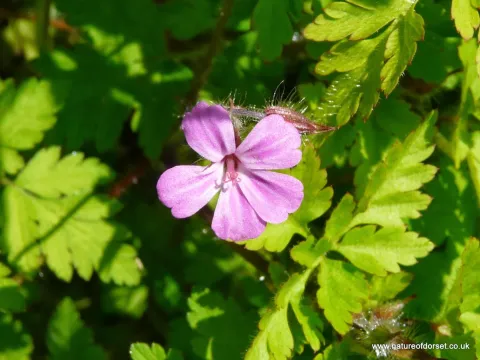In Depth
| Herb Robert |
|---|
Title: Herb Robert: The Charismatic Herb of Woodlands and HedgerowsIn the dappled sunlight of woodlands and along the verdant corridors of hedgerows, Herb Robert (Geranium robertianum) emerges as a charming and charismatic presence, captivating all who encounter its delicate beauty. Despite its unassuming stature, this humble herb possesses a rich tapestry of folklore, medicinal uses, and ecological significance. Join us as we explore the captivating world of Herb Robert, uncovering its characteristics, cultural connections, and ecological roles. Appearance and Identification: Herb Robert, also known as Robert Geranium or Red Robin, is a low-growing herbaceous plant belonging to the Geraniaceae family. It is characterized by its deeply lobed, fern-like leaves, which are tinged with red or purple hues, especially in cooler temperatures. From spring to autumn, Herb Robert produces clusters of small, five-petaled flowers in shades of pink or pale violet, each adorned with distinctive reddish stamens. Its dainty blooms and colorful foliage make it a delightful addition to woodland edges and shaded habitats. Habitat and Distribution: Native to Europe and parts of Asia and North America, Herb Robert thrives in a variety of habitats, including woodlands, hedgerows, meadows, and disturbed areas. It prefers moist, shaded environments with well-drained soil and can often be found growing in association with other woodland plants. Despite its adaptability, Herb Robert is particularly fond of calcareous soils and is often encountered in limestone-rich habitats. Cultural Connections: Herb Robert has a long history of use in folklore, herbal medicine, and superstition. In medieval times, the plant was believed to ward off evil spirits and protect against witchcraft when hung above doorways or carried on one's person. Additionally, Herb Robert was used in traditional herbal medicine to treat a variety of ailments, including wounds, digestive disorders, and respiratory complaints. Its charming appearance and perceived medicinal properties have earned it a place in gardens and herbal apothecaries throughout history. Ecological Roles: As a flowering plant, Herb Robert plays important ecological roles in its native habitats. Its nectar-rich flowers attract a variety of pollinators, including bees, butterflies, and hoverflies, contributing to the pollination of other plant species in the area. Additionally, the plant provides habitat and food for a range of insect species, further enriching the biodiversity of woodland ecosystems. Its sprawling growth habit also helps stabilize soils and prevent erosion in shaded areas. Conservation Concerns: While not currently listed as threatened or endangered, Herb Robert, like many wildflowers, faces threats from habitat loss, land development, and changes in land management practices. Conservation efforts aimed at preserving and restoring woodland habitats are essential for ensuring the continued survival of Herb Robert and other native plant species. Additionally, raising awareness about the value of woodland ecosystems and the need for their conservation is crucial for fostering a sense of stewardship and responsibility among local communities and stakeholders. Conclusion: In the tranquil realms of woodlands and shaded habitats, Herb Robert casts its spell, a charismatic presence that enchants all who encounter it. With its colorful foliage, delicate blooms, and rich cultural history, this unassuming herb adds a touch of magic to the natural world. As we continue to appreciate and protect the precious habitats where Herb Robert thrives, let us celebrate its enduring beauty and ecological importance, a testament to the intricate and interconnected web of life in woodlands and hedgerows. |

